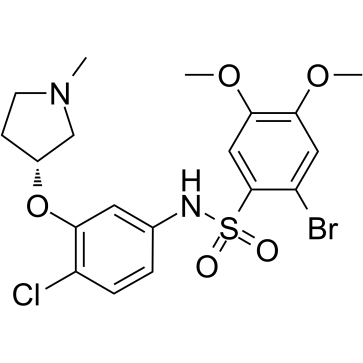474960-44-6
| Name | 2-bromo-N-[4-chloro-3-[(3R)-1-methylpyrrolidin-3-yl]oxyphenyl]-4,5-dimethoxybenzenesulfonamide |
|---|---|
| Synonyms |
Benzenesulfonamide,2-bromo-N-[4-chloro-3-[[(3R)-1-methyl-3-pyrrolidinyl]oxy]phenyl]-4,5-dimethoxy
2-Bromo-N-[4-chloro-3-[[(3R)-1-methyl-3-pyrrolidinyl]oxy]phenyl]-4,5-dimethoxy-benzenesulfonamide |
| Description | SB-657510 is a selective urotensin II (UII) receptor (UT) antagonist. The Ki values are 61, 17, 30, 65 and 56 nM for human, monkey, cat, rat and mouse receptors, respectively. SB-657510 exerts anti-inflammatory effects by inhibiting UII-induced upregulation of inflammatory mediators such as adhesion molecules, cytokines, and tissue factor in human vascular endothelial cells[1][2]. |
|---|---|
| Related Catalog | |
| In Vitro | SB-657510 dramatically blocks the UII-induced increase in adhesion between U937 and EA.hy926 cell. SB-657510 (1 μM; 0.5-8 hours) blocks the expression of tissue factor induced by UII in endothelial cells[1]. SB-706375 (1-10000 nM) inhibits [Ca2+]i mobilization elicited by 10 nM hU-II with an IC50 of 180 nM[2]. Western Blot Analysis[1] Cell Line: EA.hy926 cells (UII-induced) Concentration: 1 μM Incubation Time: 0.5, 1, 2, 4, 8 hours Result: Remarkably decreased the UII-induced protein expression of tissue factor. |
| In Vivo | SB-657510 inhibits the progression of high-fat diet induced atherosclerosis and diabetes-associated atherosclerosis[1]. Levels of phosphorylated ERK are significantly attenuated in the aorta of SB-657510-treated (30 mg/kg/day) diabetic mice (Male Apoe KO mice)[3]. |
| References |
| Molecular Formula | C19H22BrClN2O5S |
|---|---|
| Molecular Weight | 505.81000 |
| Exact Mass | 504.01200 |
| PSA | 85.48000 |
| LogP | 5.09510 |
| Symbol |

GHS07 |
|---|---|
| Signal Word | Warning |
| Hazard Statements | H315-H319-H335 |
| Precautionary Statements | P261-P305 + P351 + P338 |
| Hazard Codes | Xi |
| RIDADR | NONH for all modes of transport |
